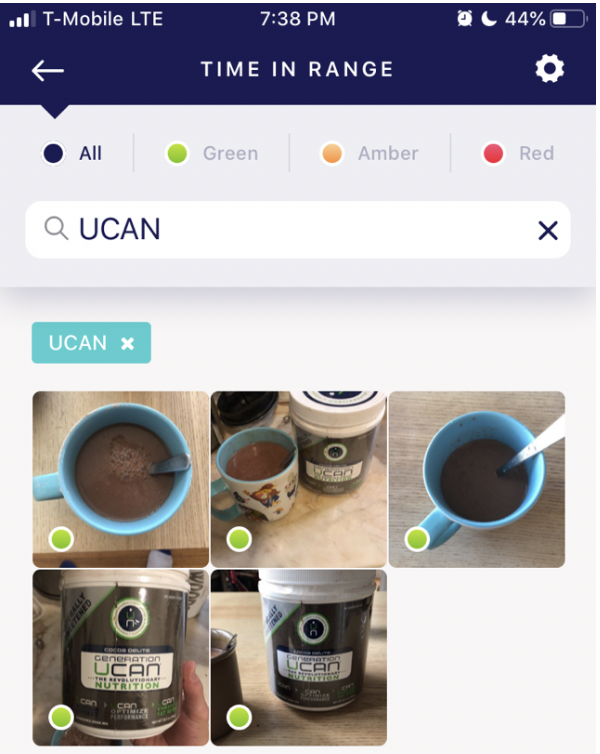Bright Spots Lab – What I’m Trying This Month
By Adam Brown
By Adam Brown
Low-carb pizza, low-cost produce home delivered, staying in-range during long exercise (UCAN), getting paid for steps, and Starbucks’ egg bites
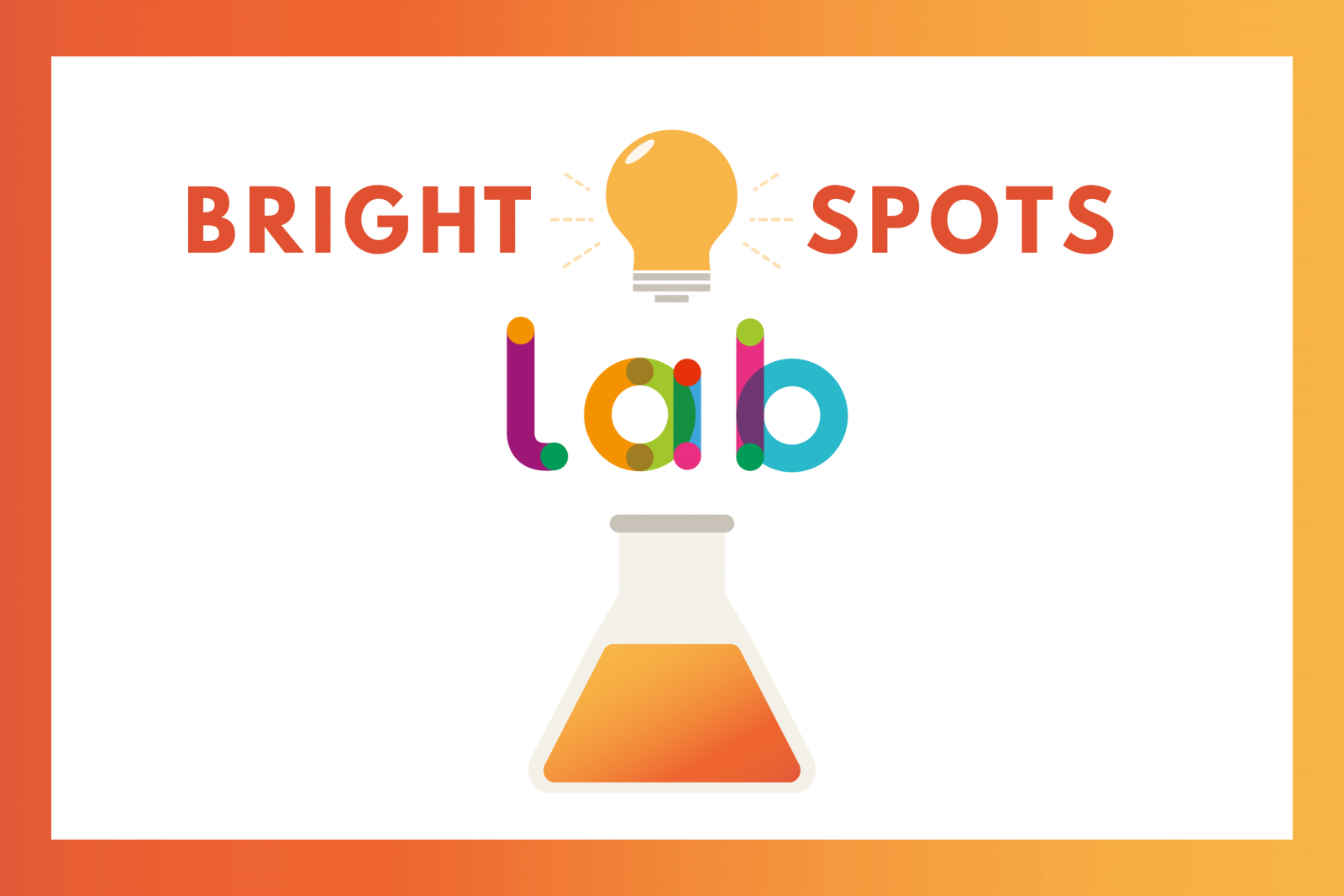
Welcome to “Bright Spots Lab” – a short-form column that shares the most helpful diabetes tips, tricks, and reading I’ve discovered of late. Each update will be added here at the same link, with all previous editions below for easy reference.
Like my book, Bright Spots & Landmines (free PDF, paperback, free audiobook), this column will focus on food, mindset, exercise, and sleep. Please let me know what you’re trying and finding helpful this month!
Contents
-
#4 – Low-carb pizza, low-cost produce home delivered, staying in-range during exercise (UCAN), getting paid for steps, Starbucks’ egg bites
-
#3 – UndermyFork: CGM + Meal Photos; The Upside of Stress & Lost Connections
-
#2 – Easy low-carb bagels, Mexican “rice” skillet, Waking Up meditation app
-
#1 – Low-carb English muffins, Atomic Habits, Digital Minimalism, Fitbit
#4 (November 2019)
FOOD
1. Low-Carb, Almond Flour Pizza Recipe: diaTribe.org/pizza
Following a few recent presentations, several people have been asking how I make low-carb pizza with almond flour at home. My go-to recipe is posted here, which redirects from the simpler short link – diaTribe.org/pizza. A few of my recent continuous glucose monitor (CGM) traces are pictured below, captured with paired photos using the app UndermyFork. Almond flour crust brings a steadier, more predictable rise in blood glucose vs. traditional pizza made with white flour. (Almond flour has more fiber and fewer carbs than white or whole wheat flour.) I use Anthony’s almond flour, though any brand will do. Make sure to roll the crust thin and flat, as it rises more than you’d expect. After the crust bakes for 15-20 minutes, I add sauce, cheese, and toppings and put it back in the oven for 12-15 minutes. With a total time of 40 minutes, this is not something I make every week, but it is the simplest, tastiest almond flour pizza recipe I’ve tried!
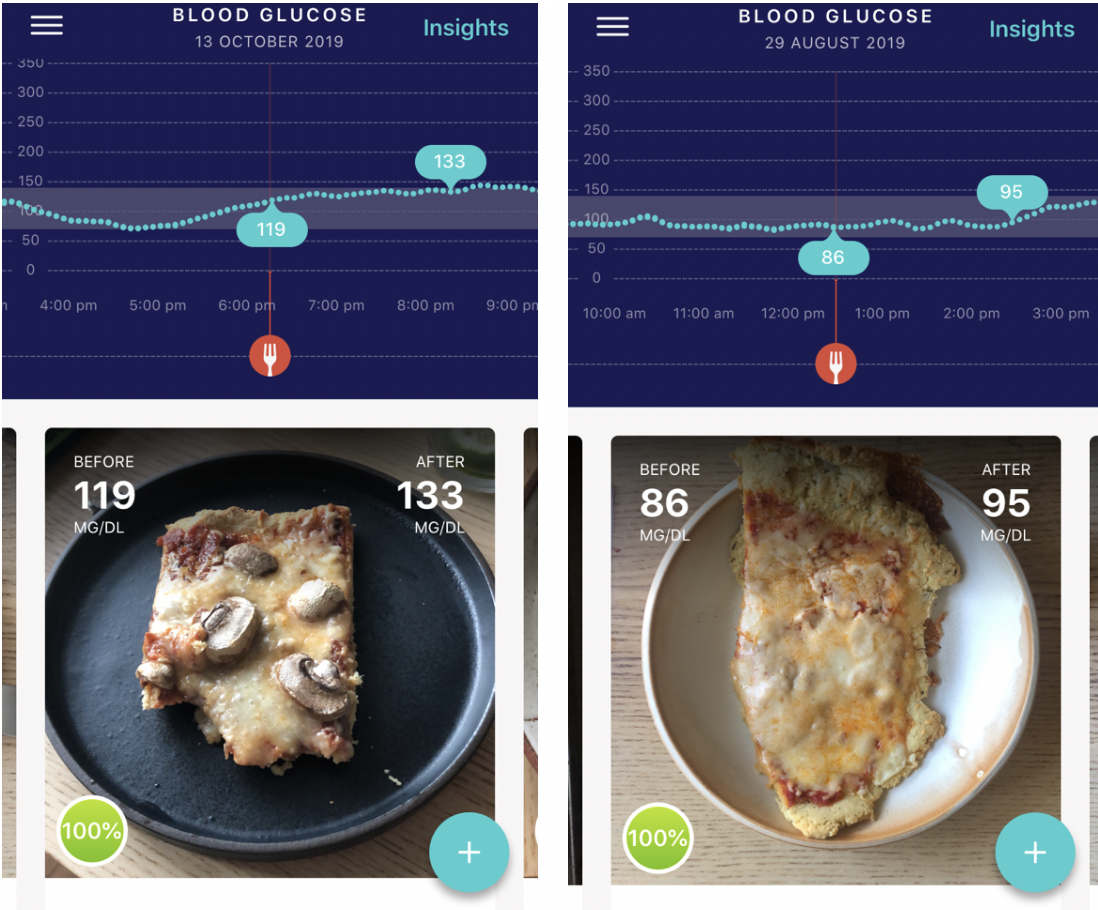
Easy-to-remember links to my other favorite low-carb recipes:
2. Low-Cost Veggies & Fruits, Home Delivered
Imperfect Foods | Misfits Market | Hungry Harvest
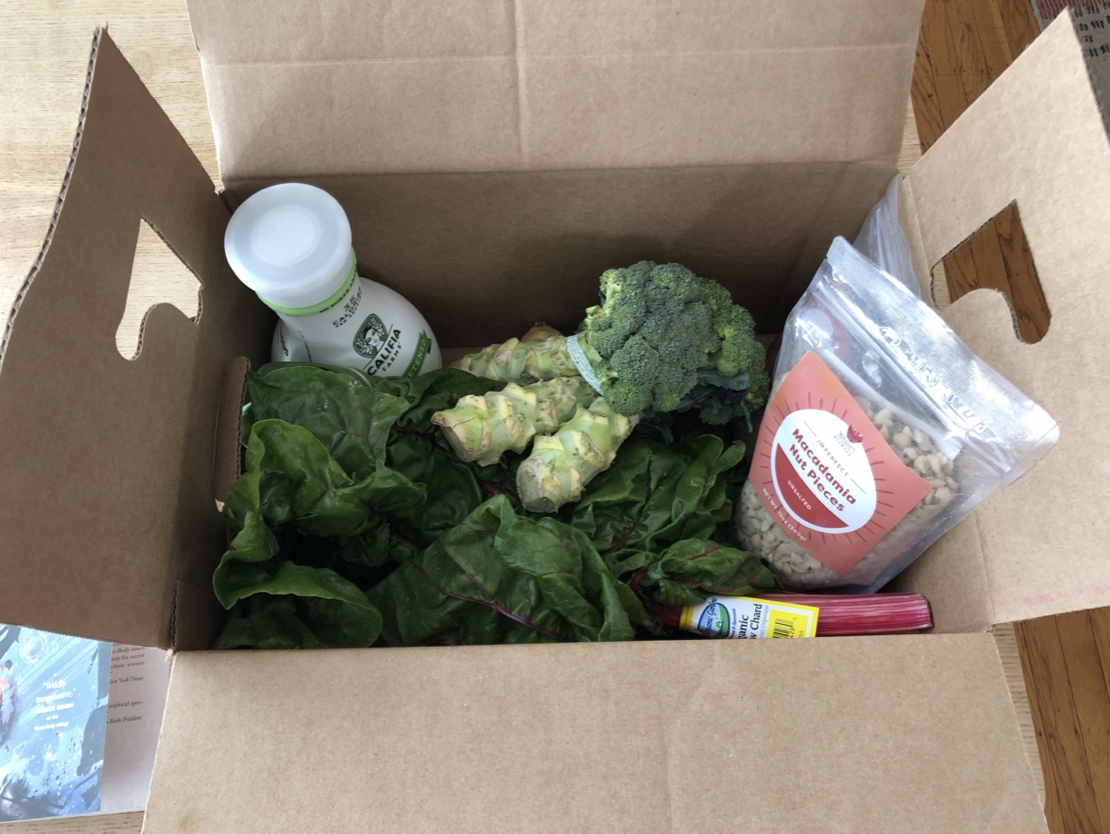 Over 20% of the fruits and vegetables grown in the US never make it off the farm because they aren't perfect enough for grocery store standards. This drives billions of pounds of wasted produce every year! Imperfect Foods addresses this problem through a beautiful service available in a growing number of US cities – they offer great produce at lower-than-grocery-store prices, conveniently deliver direct-to-door, allow you to customize a box online, and prevent food waste. We’ve been happily using Imperfect for a few years now, but I’ve never actually shared it in diaTribe. Beyond cost and delivery convenience, Imperfect also ensures there’s almost always fresh produce in our fridge – a subtle way to structure my environment and enable more Bright Spot choices. Imperfect operates in 35+ major US cities (list here), and they have expanded into pantry items too (e.g., olive oil, chia pudding supplies, nuts, etc.). If you find it hard to shop for produce, want less expensive produce, and/or want to help prevent food waste, Imperfect is a solid option. The shipping cost ($4.99 in my Zip Code) is far offset by the cheaper prices and convenience. Misfits Market and Hungry Harvest offer similar services, but more exclusively focused on the East Coast of the US.
Over 20% of the fruits and vegetables grown in the US never make it off the farm because they aren't perfect enough for grocery store standards. This drives billions of pounds of wasted produce every year! Imperfect Foods addresses this problem through a beautiful service available in a growing number of US cities – they offer great produce at lower-than-grocery-store prices, conveniently deliver direct-to-door, allow you to customize a box online, and prevent food waste. We’ve been happily using Imperfect for a few years now, but I’ve never actually shared it in diaTribe. Beyond cost and delivery convenience, Imperfect also ensures there’s almost always fresh produce in our fridge – a subtle way to structure my environment and enable more Bright Spot choices. Imperfect operates in 35+ major US cities (list here), and they have expanded into pantry items too (e.g., olive oil, chia pudding supplies, nuts, etc.). If you find it hard to shop for produce, want less expensive produce, and/or want to help prevent food waste, Imperfect is a solid option. The shipping cost ($4.99 in my Zip Code) is far offset by the cheaper prices and convenience. Misfits Market and Hungry Harvest offer similar services, but more exclusively focused on the East Coast of the US.
3. Starbucks Egg Bites – a nice low-carb option on-the-go
In my previous column on airport eating, I talked about nuts, Quest Bar protein bars, salads, and chia pudding as go-to low-carb options. But what if I want hot food?! On a recent trip to Canada, I tried Starbucks’ Egg Bites for the first time. They are delicious and resulted in pretty small blood sugar increases (see below). Starbucks’ website indicates that a pack of two Egg Bites has 9-11 grams of carbs for the three different flavors. The ingredient list is on the longer side – i.e., not something to eat every day – but it’s nice to have another predictable, lower-carb, hot option available while traveling or running errands.
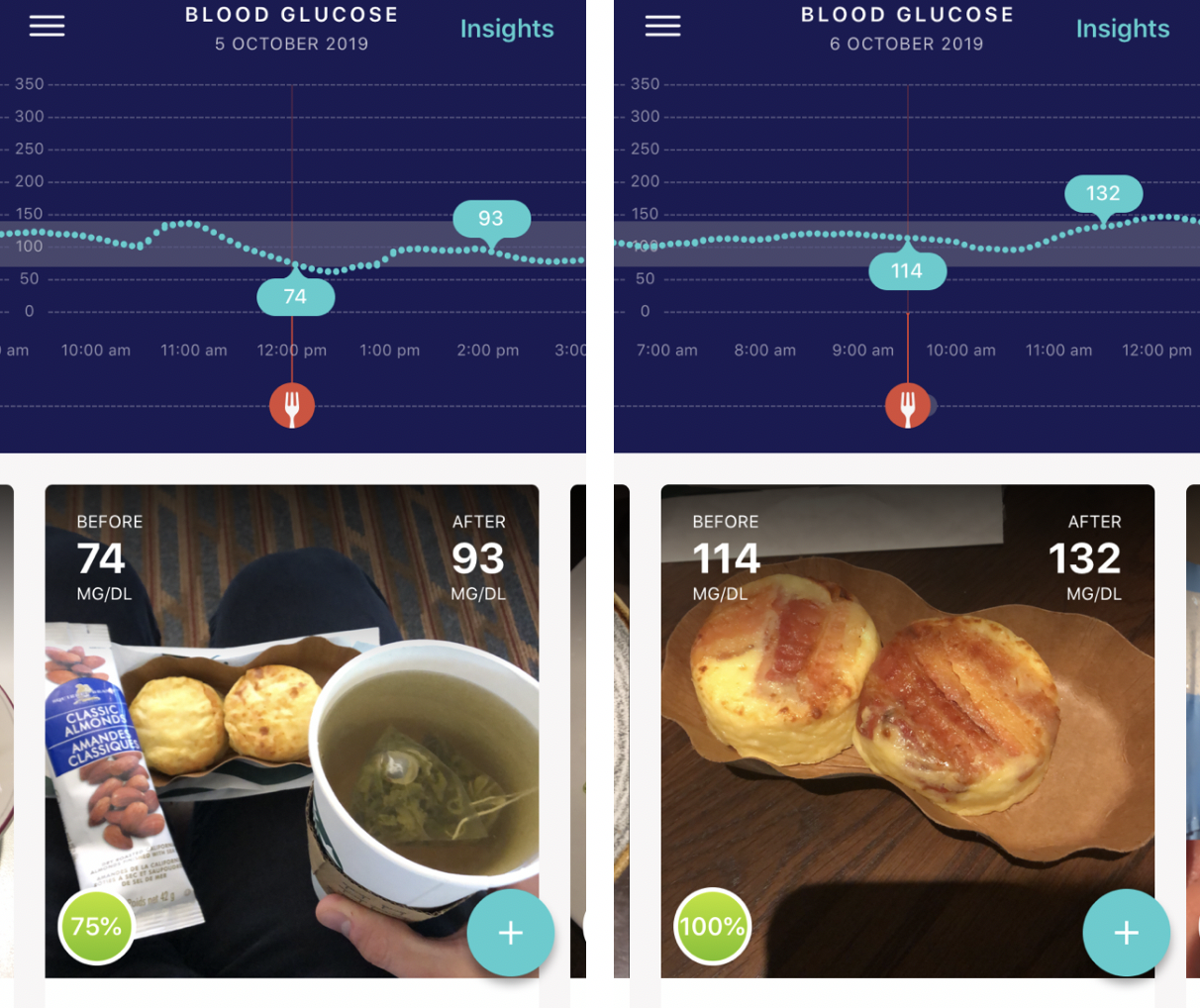
EXERCISE
1. Staying In-Range During Endurance Exercise – Generation UCAN Powder
I’m frequently asked about eating low-carb and keeping blood sugar in-range (70-180 mg/dl and the tighter 70-140 mg/dl) during endurance exercise. I do many long bike rides, primarily using two strategies: Generation UCAN Powder and “dosing” glucose tabs.
Generation UCAN Powder is a slow-digesting carbohydrate, with 20-28 grams of carbs per scoop (depending on the type purchased). The slow-and-steady blood sugar rise from UCAN perfectly matches the fall I usually see from cycling for rides over 60 minutes. I mix one scoop of UCAN into water 30 minutes before a long bike ride. The timing is critical here, as eating too far before exercise can leave blood sugar unnecessarily high, while eating too close to exercise can lead to early-exercise lows and later rebound highs (i.e., the food sits in my stomach during exercise and only start to raise blood sugar after exercise is over).
In many careful tests, UCAN has improved my time in range during long bike rides, and it does not require fiddling with basal insulin. For a bike ride that is 90-120 minutes, one scoop of UCAN generally covers my needs, assuming I’m starting around 100-130 mg/dl. For longer rides or lower starting glucose values, I’ll add “doses” of glucose tabs along the way – based on my CGM trend. I know one glucose tab raises my blood glucose by about 20 mg/dl, so I’ll dose tabs accordingly to stay in-range. If you’re wondering, “Why glucose tabs?”, it’s for predictability (they work immediately), easy-to-remember measurement, and portability.
You can see some tests below of long bike rides (90-180 minutes), all using one or both of these strategies. The biggest downside to UCAN is the price, coming out to $2 per serving on Amazon (i.e., $60 for a 30-serving tub; it’s more expensive per-serving on UCAN’s website.) I’ve only tried the cocoa flavor. The UCAN website has great background on the development of “SuperStarch” – it started with a rare glycogen disorder that required tube-feeding every two hours to maintain normal blood sugar levels.
-
Left: August 17 – I took one scoop UCAN 30 minutes prior to a two-hour bike ride, eating glucose tabs along the way. I made no other changes to basal or bolus insulin.
-
Right: September 8 – I took one scoop of UCAN 30 mins prior to a three-hour bike ride, eating glucose tabs along the way. I made no other changes to basal or bolus insulin.
-
Bottom: All five UCAN experiments I’ve logged in UndermyFork, with all the rides over 90 minutes and time in range between 70%-100% (green dot; I use a target of 70-140 mg/dl).
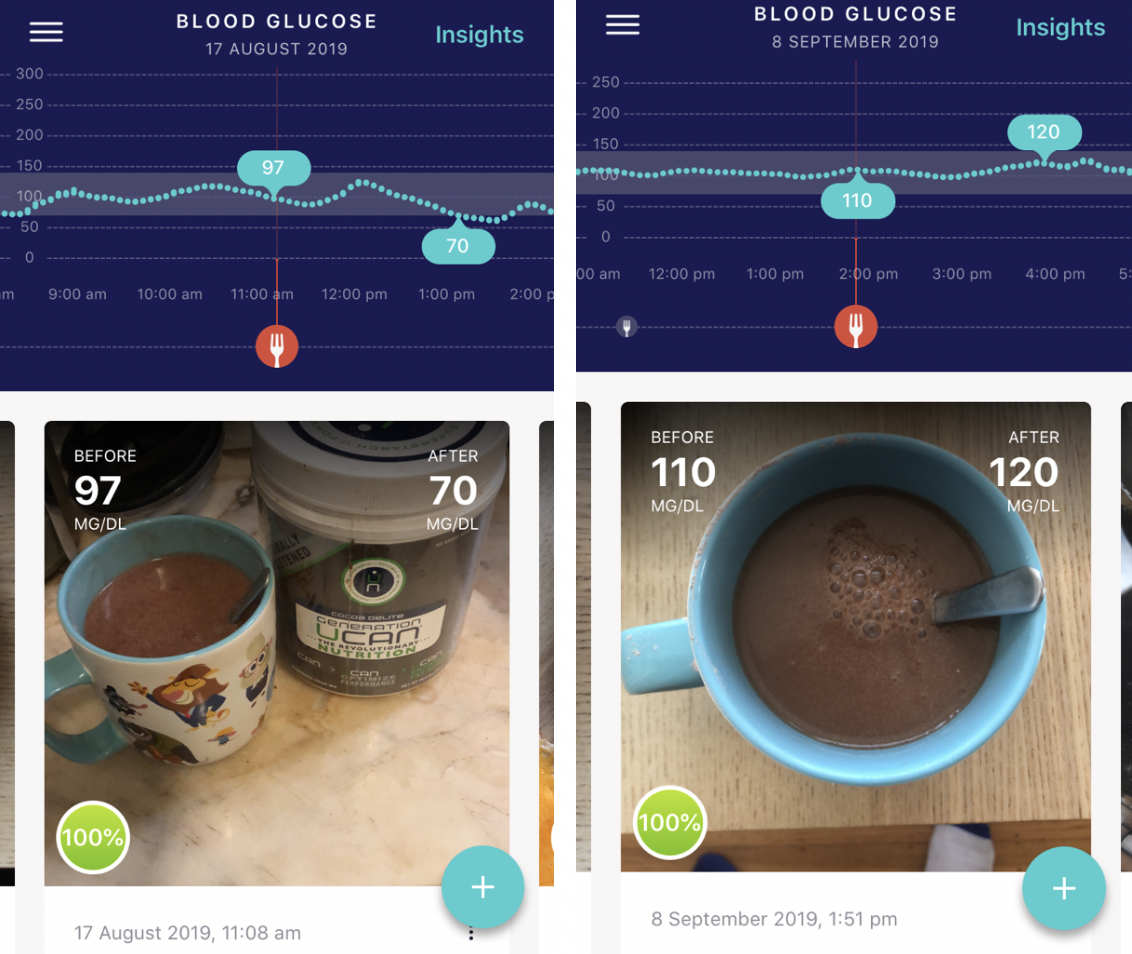
For shorter bike rides (less than 60 minutes), I typically just dose the glucose tabs 15 minutes before (or during) activity to stay in-range, based on where my blood glucose is starting. From my column on exercise questions, I know cycling usually drops my blood glucose by about 1-2 mg/dl per minute, so a 60-minute ride is about a 60-120 mg/dl drop. With that in mind, I know roughly how many tabs to eat to stay in-range without going overboard. For a deeper dive on this topic, see chapter three of Bright Spots & Landmines (free PDF, paperback).
2. Get Paid for Steps: Achievement (Evidation), Attain by Aetna
There are a growing number of apps that will pay you for sharing activity and health data, and two I’ve been testing are Achievement (Evidation) and Attain by Aetna. Achievement works with many devices and apps; I’m averaging about $10 earned every four months. (Delivery options: Amazon gift card, PayPal, direct deposit, charity donation.) Attain only works with Apple Watch and Aetna members; in about three months of use, I’ve earned over $50! UnitedHealthcare has a similar program called UHC Motion (offered through employers), and it’s possible your insurance company has a similar program. Of course, not everyone may want to share their personal health data (it’s almost always anonymized), but I’m excited to get rewarded for consistently taking steps!
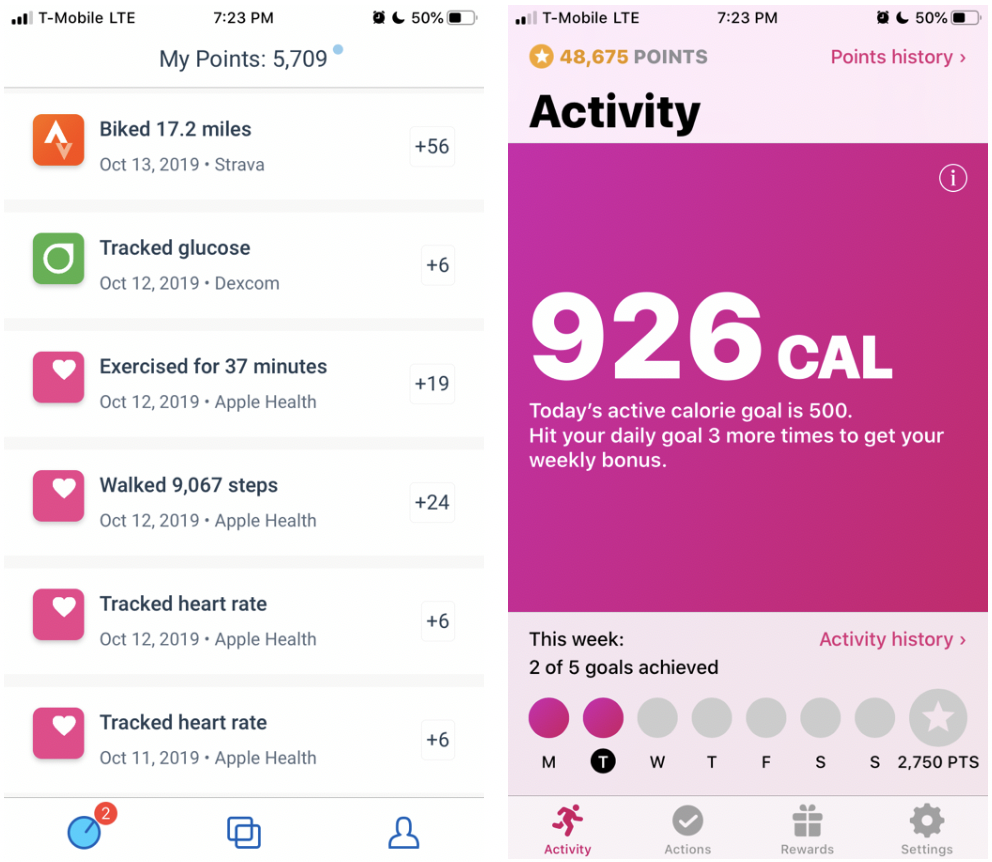
READING
Feedback is a huge part of diabetes, and it can easily be delivered in ineffective or downright unhelpful ways – including our own internal feedback, views from loved ones, and opinions from healthcare providers. I relished reading The Feedback Fallacy, a great Harvard Business Review article written for managers. It reminded me of so many aspects of “Bright Spots” vs. “Landmines” thinking in diabetes. If I want to improve, should I focus on building strengths or fixing weaknesses? It’s a good read on this topic!
Did you catch our new 42 Factors That Affect BG Poster and Booklet? We’ve heard great feedback on them!
diaTribe.org/42FactorsPoster - free poster download
diaTribe.org/42FactorsExplained - free booklet download
ShopdiaTribe.org - purchase a beautiful printed version
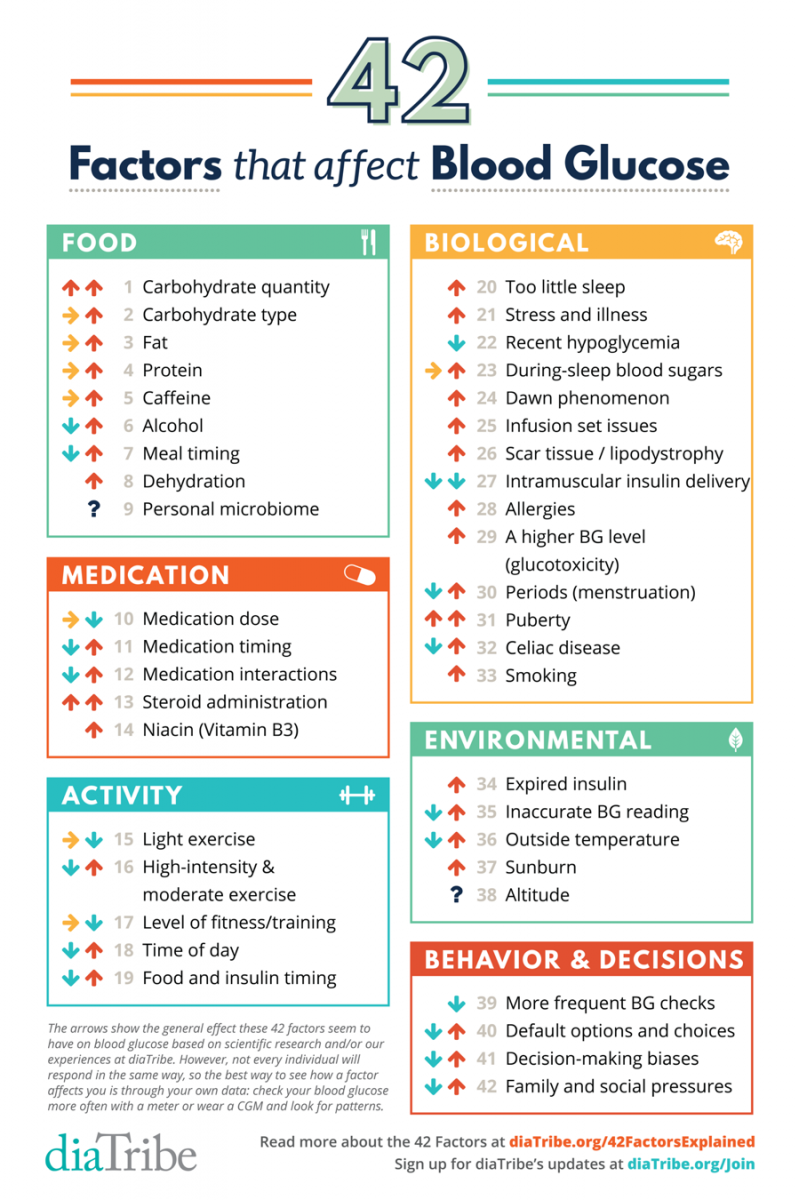
Previous Editions
#3
FOOD
1. UndermyFork: CGM + Meal Photos!
.png)
UndermyFork is an excellent new iPhone app for diabetes food logging with photos. Similar to the no-longer-available Meal Memory, UndermyFork overlays glucose data on a meal photo, enabling useful pattern recognition: what foods keep my glucose in-range (Bright Spots) vs. driving it out-of-range (Landmines)? I’ve been using it with the Dexcom G6 continuous glucose monitor (CGM), and the app pulls glucose data automatically from Apple Health. Logging a meal requires just a few clicks – take a photo and hit “save” (no typing required). Then, I return to see the CGM response associated with that meal photo. The enclosed pictures are my own data.
UndermyFork reports time-in-range in the two-hour period after a meal (green badge on left side), and an “Insights” section sorts meals into high, medium, and low time-in-range – it’s useful for recognizing Bright Spot and Landmine patterns, and you can customize the range (e.g., 70-140 vs. 70-180). Impressively, the app can often recognize what’s in the meal based on the photo .png) alone (it pulls up the appropriate tags, like “asparagus”), though it’s not perfect – I’d say about 75% correct, which still saves time, and presumably it will get better. Finally, it lets you search for previous entries, which enables useful learning: “What happened the last time I ate ____?”
alone (it pulls up the appropriate tags, like “asparagus”), though it’s not perfect – I’d say about 75% correct, which still saves time, and presumably it will get better. Finally, it lets you search for previous entries, which enables useful learning: “What happened the last time I ate ____?”
The app is available now on iPhone and the team is seeking feedback – I encourage you to try it if you have a Bluetooth-enabled CGM or blood glucose meter that sends data to Apple Health. Dexcom CGM users on iPhone will be the most likely target market based on the current design. The UndermyFork team told me that insulin logging and smarter pattern recognition are top priorities to add to the app. (Both are still somewhat manual for now.) I’m finding UndermyFork useful for capturing food experiments in a low-hassle way – it took under two minutes to set up and has proven sustainable for logging over 150 meals now. We firmly believe that food photos – paired with CGM data and simple pattern recognition – offers huge potential to improve time-in-range.
.png)
.png)

MINDSET
2. Two Paradigm-Shifting Books on Stress, Depression, and Anxiety: The Upside of Stress and Lost Connections
The Upside of Stress by Dr. Kelly McGonigal – Is it helpful to believe that “stress is toxic?” This persuasive book urges a reframing of beliefs around stress, shifting from a “stress-is-toxic” to a “stress-is-enhancing” mindset. Dr. McGonigal has a TED talk with 20 million views on this same topic, and Stanford has a great one-hour free video course summarizing more of the research.
These two grounding insights are what got my attention:
-
“Stress is what arises when something you care about is at stake … Stress and meaning are inextricably linked. You don’t stress out about things you don’t care about, and you can’t create a meaningful life without experiencing some stress.”
-
“Most people don’t choose the stress in their lives; they deal with it. When asked what is most stressful about their lives, people typically name things like a loved one’s health problems, money worries, academic pressure, work stress, and parenting demands. We can’t just excise these things from our lives to reduce stress. When people can’t control what is stressful about their lives, how does it help to tell them that the reality of their lives is unacceptable?”
From these viewpoints, a life with “zero stress” is undesirable and impossible - it would mean not caring about anything and having complete control over everything! I really appreciate this framing, since it changes the game in a major way – from an unrealistic goal to “eliminate all stress” to the more realistic “stress is going to come up – because I care about things – but it’s possible to deal with it.” The Upside of Stress has good tips on how to cope with stress productively, along with fascinating science on “stress mindsets” – how beliefs about stress might impact the actual hormonal impact stress has on the body.
Lost Connections by Johann Hari – This marvelous book disrupts the paradigm that depression is simply a “chemical imbalance” in the brain with a simple pill fix. Hari persuasively argues that depression and anxiety are highly driven by many levels of “disconnection” in our lives: from meaningful work, other people, the natural world, a hopeful and secure future, and more. The book summarizes nine causes of anxiety and depression, and then it offers a “different kind of antidepressant” – seven types of “reconnection.” Hari struggled with depression for many years, and the book combines his personal experience with great science writing. Like Why We Sleep, Lost Connections has certain pages in which I underlined almost everything. Paired with The Upside of Stress, these books paint a far more comprehensive and nuanced picture of negative mental states – especially for those of us with diabetes who might cope with stress and disconnection almost daily.
Tip for free audiobooks and eBooks: Use the Libby app to borrow books from your local library (Apple or Android). I’ve been using it for over a year now, and it’s easily saved me hundreds of dollars.
Food Bonus: Low-Carb Almond Flour Bread
I’ve confirmed that the low-carb bagel recipe mentioned in Lab #2 can be made in a bread loaf tin. It’s equally great!


#2
FOOD
1. Easy Low-Carb Bagels Made with Almond Flour – Recipe
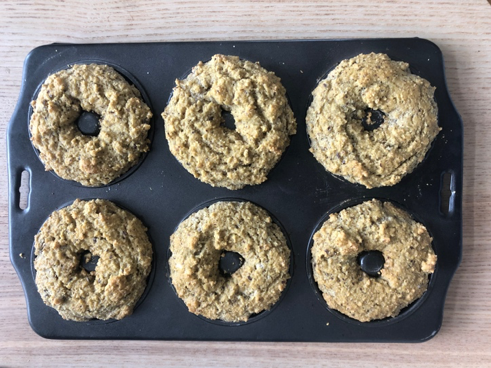
I rediscovered this phenomenal low-carb, almond flour bagel recipe in the Elana’s Pantry Paleo cookbook, and it is also posted on her blog. The recipe makes six bagels, takes about five minutes to prep, cooks in the oven in 20-25 minutes, and uses straightforward ingredients that were already in my pantry (rare!). Two adjustments I made for simplicity: I mix the ingredients by hand instead of using a food processor (I don’t own one), and I spoon the batter into the baking tin instead of piping them with a plastic bag. Making one bagel batch on Sunday provides enough for the week (they store well in the fridge), and these end up less expensive than the store-bought Mikey’s low-carb muffins (see Lab #1). Sliced in half, I’ve been topping these bagels with sliced avocado or an egg, with little impact on blood sugar. (For me, 1U of insulin covers one bagel, equivalent to ~10 g of carbs.) This recipe is also sustainable – I’ve baked them four times in the past month. I own a pan like this one, but I’d guess the same batter could be cooked in a bread loaf tin or a muffin tin. Get the recipe here!
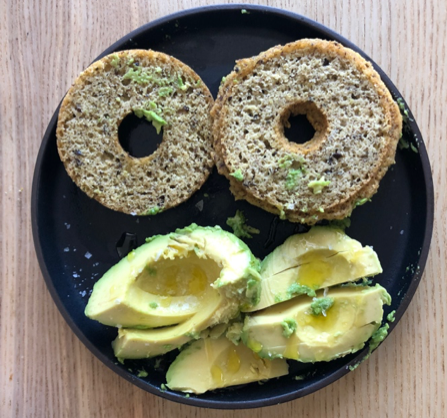

2. Low-Carb Mexican “Rice” Skillet – Recipe
The All Day I Dream About Food blog really delivers on low-carb creativity. Looking for ideas to share in this column, I attempted a Low-Carb Mexican Cauliflower Rice skillet recipe – it turned out fantastic and easy to make. As soon as my girlfriend and I took a bite, we looked at each other and said, “Wow – this is a keeper!” We used less cheese than the recipe calls for, and, when we cook it next time, I’ll use a bit less chicken broth.
In case it is useful: I save “keeper” recipes in Evernote for easy on-the-go access and searching.
MINDSET
3. App I’m using nearly every day: Waking Up
I’ve followed Sam Harris’s work for a long time, and I highly recommend his new meditation app – Waking Up, available on Apple and Android. I try a lot of health apps, but end up deleting 98% of them. (Apps must add more value than burden, and that is rarely the case.) I’ve not only stuck with Waking Up, but paid for a one-year subscription – it’s that good. The app has a free trial and a money-back guarantee. Sam is a neuroscientist and approaches meditation from a slightly different perspective – mental training for life and a tool to understand how the mind works, rather than simply “stress reduction.” I’ve found meditation to be the most powerful tool for recognizing diabetes thinking traps and negative thought spirals. Waking Up’s three-minute lesson on gratitude is also incredible; I’ve listened to it alone at least ten times, and it immediately improves my mood. Try Waking Up if you are even the least bit intrigued; I also recommend Buddhify, Calm, Headspace, and Ten Percent.
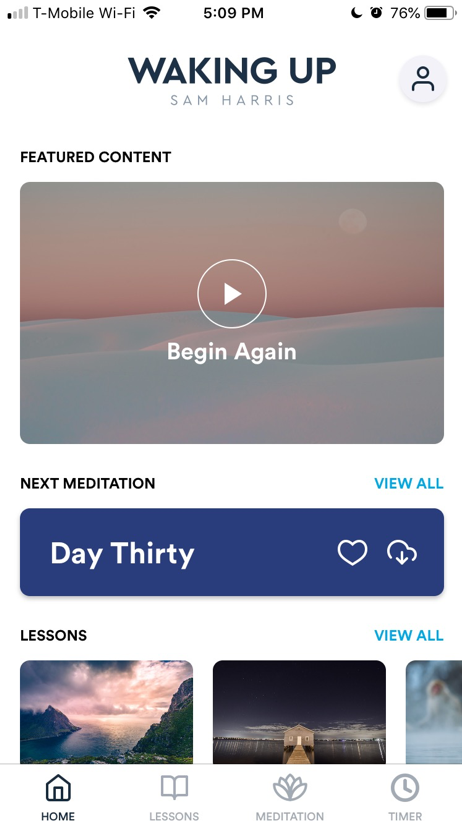
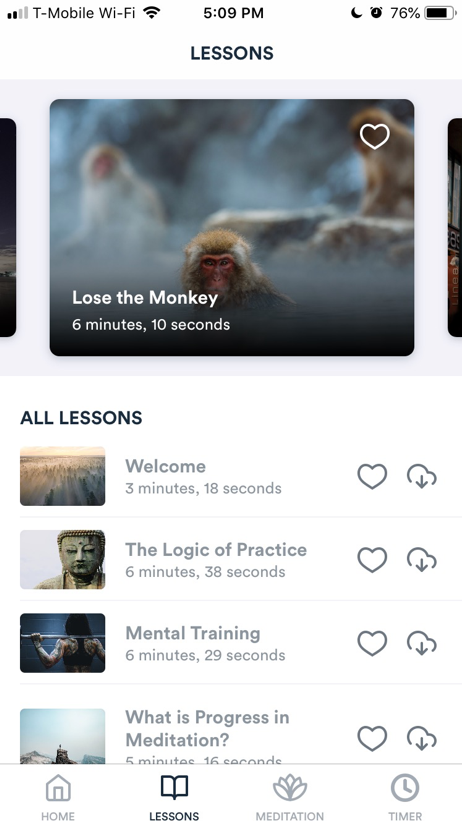
READING
4. Why are Nutrition Headlines So Confusing?
The other day, I was explaining to someone why nutrition headlines in the media are so confusing – how can one diet or food be “healthy” one month and “unhealthy” the next month? Chris Kresser answers that question pretty well in a two-part blog: “Why You Should Be Skeptical of Latest Nutrition Headlines.” Dr. Peter Attia’s weekly email also has an amazing step-by-step rebuke of a recent breakfast study. These two articles provide a thinking toolkit to separate rigorous nutrition science (rare) from sensationalist headlines (common). Personally, I try to combine data from different sources: test different diets and observe the impact on my own health data (time-in-range, hypoglycemia, insulin needs, heart health); read the research; and learn from other people with diabetes.
5. A remarkable book – Motivational Interviewing: Helping People Change by William Miller and Stephen Rollnick
This incredible book is written for healthcare providers and mental health professionals, but is loaded with gems for becoming a better listener and having more effective conversations with anyone. Motivational interviewing (MI) is all about helping people find their own solutions, rather than just giving advice and expecting it to be followed. MI is grounded in a powerful premise: many of us are “ambivalent” about change, meaning we have reasons for and against changing. Interestingly, when a “helper” provides a bunch of reasons in favor of change (“the righting reflex”), an ambivalent person will naturally respond with several reasons not to change. Avoiding the “righting reflex” is a central focus of MI, and it is both conversational art and science. Here’s a thought experiment early in the book that resonated:
-
Choose something that you have been thinking about changing, but haven’t done so yet. Now, imagine a friend (“helper”) who tells you how much you need to make this change, gives you a list of reasons for doing so, emphasizes the importance of changing, tells you how to do it, and tries to motivate you to get on with it. How would you be likely to respond? Most often, the “helped” person feels defensive, uncomfortable, powerless, or angry. Sometimes, the person being helped even concludes that he or she actually doesn’t want to make the change. That was not the helper’s intention; it’s just how people normally respond to the “righting reflex.”
-
Motivational Interviewing is more person-centered, anchored in the belief that people are the experts on changing themselves. Imagine the same thought experiment, but instead of the approach described above, the helper asks these questions: Why would you want to make this change? How might you go about it in order to succeed? What are the three best reasons to do it? How important is it for you to make this change, and why? The helper listens, gives a short summary of all the reasons you just shared, and then asks one more question: “So what do you think you’ll do?” With an ambivalent person, there are reasons in favor of change; MI just helps call them out.
This is a hefty book, but it’s one I’m going to save and re-read many, many times. If you are a healthcare provider and never received training in MI, I highly recommend this read.
#1
FOOD
1. Best New Find: Mikey’s Low-Carb English Muffins
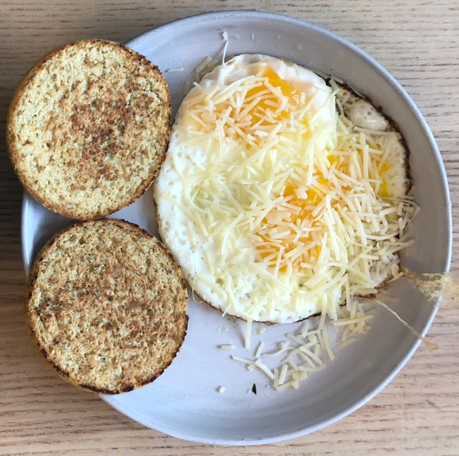
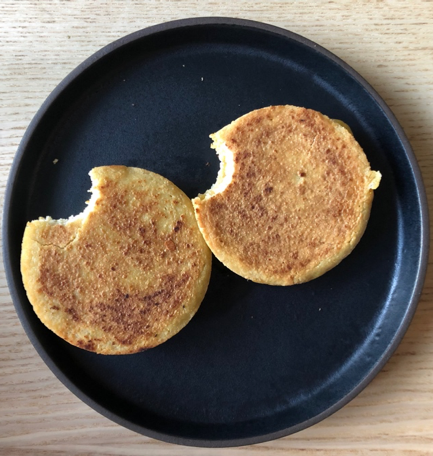
I stumbled across these in the frozen section of a nearby grocery store – wow are they awesome! Each Mikey’s English muffin has 8 grams of carbs total (50% from fiber) and seven real-food ingredients: Eggs, Almond Flour, Water, Apple Cider Vinegar, Coconut Flour, Baking Soda, Salt. They have minimal impact on blood sugar in my ten experiments so far. These muffins make a killer breakfast egg sandwich – I put one fried egg on each half and eat it open face. My girlfriend, Priscilla, also enjoyed my grilled cheese attempt (see above). Since the muffins are sold in a frozen four-pack, I thaw one in the refrigerator overnight and then toast it in a hot pan before eating. (I don’t own a toaster oven, though that’s probably the best way to make them.)
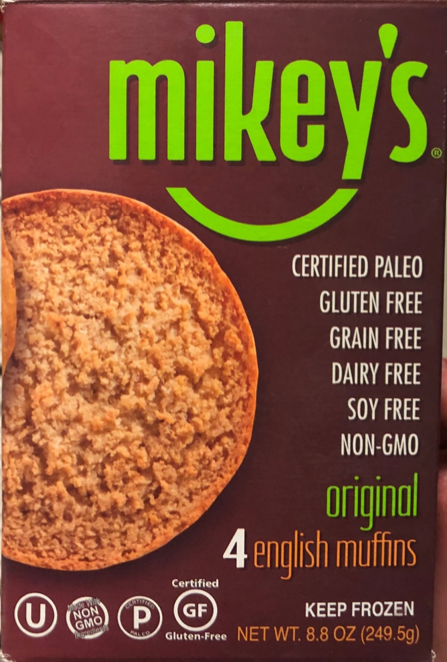
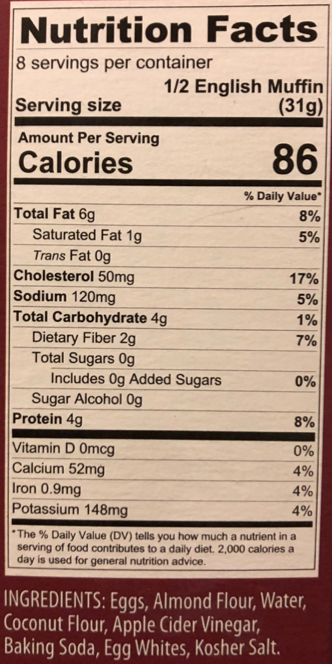
The one downside is price: a four-pack ran about $6, meaning each muffin comes to about $1.50 – more expensive per-serving than breakfast chia pudding, but a nice way to mix it up. Mikey’s has a store locator here, and it seems they are available at Whole Foods and Safeway. This past weekend, I found a way to make a similar version of these at home – higher hassle, but far less expensive – and I’ll share that in the next Bright Spots Lab.
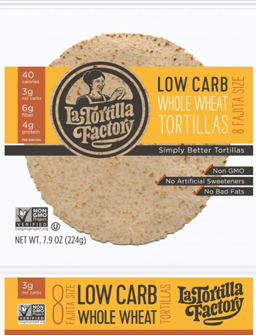 I don’t generally eat a lot of packaged foods, but these muffins are great to have in the freezer when time is crunched.
I don’t generally eat a lot of packaged foods, but these muffins are great to have in the freezer when time is crunched.
On a related note, La Tortilla Factory’s low-carb, high-fiber, whole wheat tortillas are excellent for breakfast egg burritos, tacos, etc. They have a yellow-branded package (“Low Carb”), are sold at many grocery stores – search your zip code here – and are much cheaper than Mikey’s. Since over 70% of the carbs are from fiber (8 grams of fiber, 11 grams of total carbs), they have a similarly small impact on blood sugar.
2. Favorite New Recipe: Ground Turkey + Broccoli “Rice” Bowl
Broccoli and cauliflower rice are sold pre-blended at stores like Trader Joe’s, offering a low-carb, rice-like, vegetable-only side dish or main course. This recipe is a serious winner – with broccoli rice, it tasted just like a stone-bowl rice dish. We skipped the maple syrup, used soy sauce instead of coconut aminos, and added an egg on top. The recipe says it works with cauliflower or broccoli rice, but it was far better with broccoli rice in my view. If you prefer, you can make cauliflower or broccoli rice at home in five minutes – see here.
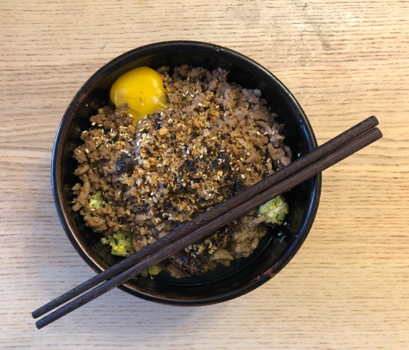
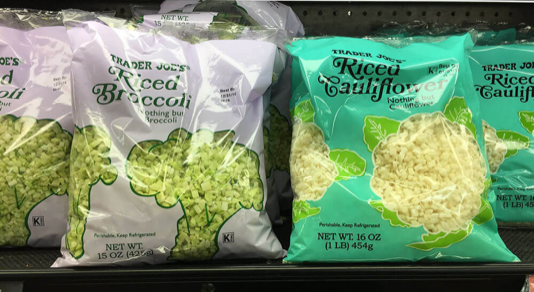
MINDSET
3. Outstanding books:
Digital Minimalism by Cal Newport: This book makes a compelling case for re-evaluating one’s relationship with smartphones and social media. The average person spends three hours per day looking at a smartphone screen, with only 12% spending less than an hour. Note: three hours per day = 46 full days per year! I’ve long used related tools like RescueTime, Freedom, and the iPhone Screen Time report. This book provides a good high-level strategy (and tips) for thinking about the place phones and social media should have in our lives. I see huge diabetes opportunity in cutting even 20 minutes per day in screen time, freeing that up for self-care – walking, more sleep, morning breathing, etc. Taking long walks without my phone has been a great addition to my toolbox after reading this book.
Atomic Habits by James Clear: This book has a crystal-clear structure and great stories for explaining how habits work. I loved the emphasis on tiny (“atomic”) changes – e.g., if you get 1% better each day, you will be 38-times better in a year! Atomic Habits builds nicely on the 2012 classic, The Power of Habit by Charles Duhigg. Combined with Switch by Chip and Dan Heath, these are the three best books I’d recommend for anyone trying to improve their habits. The Mindset chapter of Bright Spots & Landmines has many similar themes.
I’ve also been re-reading and recommending Cognitive Behavioral Therapy Made Simple by Dr. Seth Gillihan, especially the chapter on negative thoughts and thinking errors – it is stunningly good for combatting unhelpful diabetes thought loops.
EXERCISE and SLEEP
4. Switching back to Fitbit from Apple Watch.
I used Fitbit from 2011-2016 and loved the motivation to walk more, to encourage my friends, and to get sleep data. In 2016, in a Black Friday moment of inspiration, I splurged on a discounted Apple Watch Series 1; I was mostly excited to get Dexcom CGM data on my wrist. In January of this year, however, I was feeling extra device fatigue and decided to switch back to Fitbit. It’s been an awesome change! I find Fitbit’s wrist-worn tracker and app more motivating and less naggy than Apple Watch. Fitbit has valuable, built-in sleep data, whereas Apple Watch requires third-party apps. Fitbit excels on battery life too, needing only one charge per week. I haven’t missed getting CGM data on my wrist, as it’s one swipe from the iPhone lock screen. In fact, I do less micromanaging and less stressing about my blood sugars now. My time-in-range is identical since the device change.

.png)
Please send questions and feedback here.
.jpg) Over 100,000 copies of Bright Spots & Landmines: The Diabetes Guide I Wish Someone Had Handed Me have been sold/downloaded! Get it as a…
Over 100,000 copies of Bright Spots & Landmines: The Diabetes Guide I Wish Someone Had Handed Me have been sold/downloaded! Get it as a…
- Free PDF download or buy it on Amazon in paperback ($6) or Kindle ($1.99)
- Free audiobook on diaTribe or YouTube, or buy it at Audible, Amazon, iTunes
- mmol/L version: free PDF and in paperback at Amazon UK and Amazon Canada

